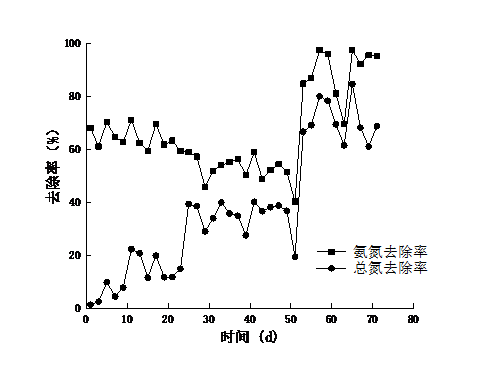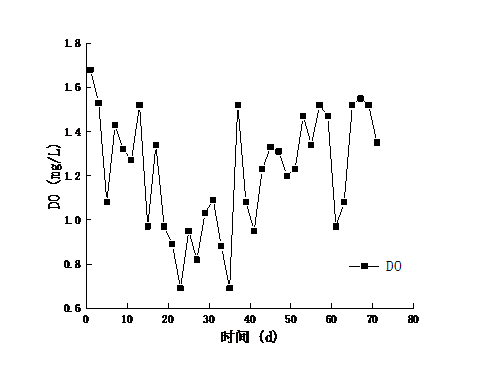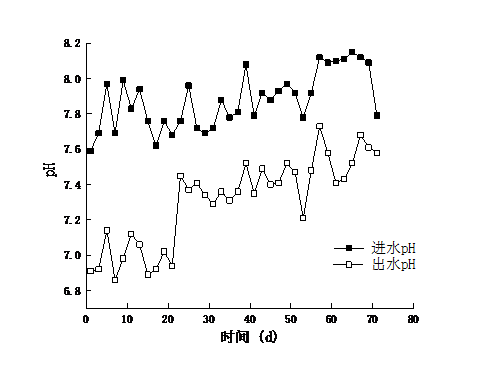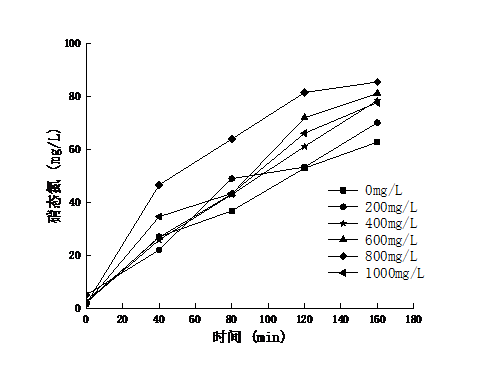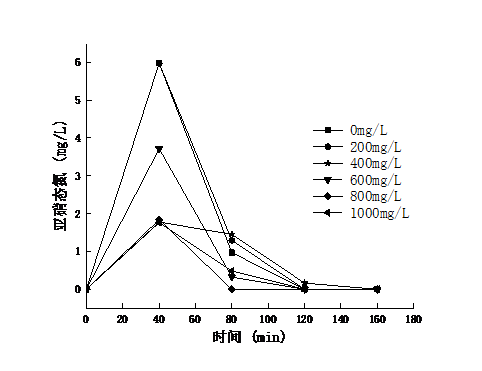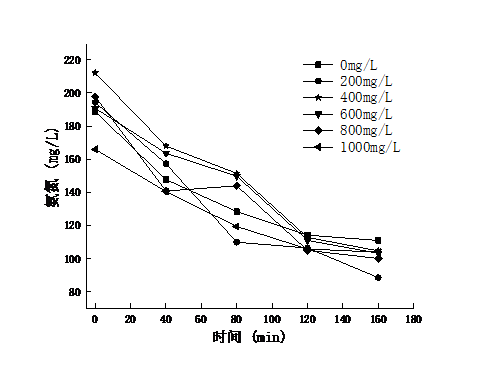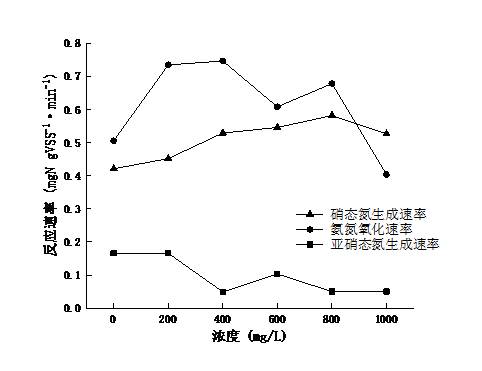单级自养脱氮系统的构建及外源材料对系统的影响毕业论文
2020-02-19 15:21:54
摘 要
目前,由于大量未经妥善处理的废水排入水体中,造成水体中氮元素大大超标,容易引起水体富营养化,造成水环境质量恶化程度加剧。传统硝化-反硝化工艺已不能满足日益增长的脱氮需求,且运行这一工艺,需要消耗氧气、有机物质,使得处理大量废水的成本较高,所以寻求一种新型脱氮工艺十分有必要。
因全程自养脱氮工艺相较于传统脱氮工艺,对氧气、有机物质的需求大大减少,且剩余污泥的产生量较少,处理含有高氨氮的废水的效果好,是目前国内外研究的热点内容。本文研究的全程自养脱氮工艺是基于亚硝化及厌氧氨氧化的原理上所形成,首先通过废水中的部分氨氮转化成亚硝态氮,而后,在厌氧氨氧化细菌的作用下,将废水中未参与反应的氨氮以及上一过程生成的亚硝态氮转化成氮气,以期脱去废水中的氮素。
本研究主要分为两个过程。第一阶段是在短程硝化反应器的基础上,启动自养脱氮过程,分析了运行期间(0-71 d内)自养脱氮系统内氨氮、亚硝态氮、硝态氮、以及pH值的变化规律;第二阶段在自养脱氮工艺成功启动后,通过向反应器内投加不同浓度的磁铁矿(0、200、400、600、800、1000 mg/L),分析了磁铁矿及其投加量对自养脱氮过程的影响。并得到如下结论:
(1)反应器运行57 d后,模拟废水的氨氮去除率达95.1%,总氮去除率达到80%,且在57 -71 d的反应时间内,氨氮去除率稳定在90%以上,总氮去除率维持在70%,因此可以认为单级全程自养脱氮系统成功启动。通过对实验数据进行分析,系统对氮素的去除效果与反应器内的溶解氧浓度密切相关,因此为了获得稳定的脱氮效果,应严格控制溶解氧浓度。同时需要定期对缓冲桶进行清洗,防止黏着的丝状细菌大量繁殖,阻碍氧气的传递。
(2)投加一定量(0-800 mg/L)的磁铁矿可以在一定程度上强化自养脱氮的氨氮去除率,其中磁铁矿的投加量为200 mg/L时,氨氮去除率最高,为54.46%。而不添加磁铁矿的对照组则为38.59%;投加量为1000 mg/L,对氨氮的去除率明显下降,为35.02%。反应期间内的pH先升高后降低。
关键词:全程自养脱氮;磁铁矿;短程硝化;厌氧氨氧化;含氮废水
Abstract
At present, due to a large number of untreated wastewater discharged into the water body, the nitrogen element in the water body greatly exceeds the standard, which is easy to cause eutrophication of the water body and aggravate the deterioration of the water environment quality. The traditional nitrification-denitrification process can not meet the increasing demand for nitrogen removal, and the operation of this process requires the consumption of oxygen and organic matter, which makes the cost of treating a large number of wastewater higher, so it is necessary to find a new denitrification process.
Compared with the traditional denitrification process, the whole autotrophic denitrification process greatly reduces the demand for oxygen and organic substances, and the sludge production is low. It has a good effect on the treatment of high ammonia nitrogen wastewater, which has become a research hotspot at home and abroad. Based on the principles of nitrification and anaerobic ammonia oxidation, the whole autotrophic denitrification process firstly converts part of ammonia nitrogen in limited nitrification wastewater into nitrite nitrogen. Then, the anaerobic ammonia oxidation bacteria take the non-reactive ammonia nitrogen in wastewater as electron donor and the generated nitrite nitrogen as electron acceptor to produce nitrogen gas in order to remove the nitrogen in wastewater.
This study is divided into two main processes. In the first stage, the autotrophic denitrification process was started on the basis of short-cut nitrification reactor, and the variation rules of ammonia nitrogen, nitrite nitrogen, nitrate nitrogen and pH value in autotrophic denitrification system during operation period (0-71 days) were analyzed. In the second stage, after the successful start-up of autotrophic denitrification process, different concentrations of magnetite (0, 200, 400, 600, 800, 1000 mg/L) were added into the reactor. The effect of magnetite and its dosage on autotrophic denitrification process was analyzed.
After 57 days of operation, ammonia nitrogen removal rate reached 95.1%, total nitrogen removal rate reached 80%, and in 57-71 days of reaction period, ammonia nitrogen removal rate stabilizer rod was above 90%, total nitrogen removal rate maintained at 70%, so it can be considered that the single-stage full-course autotrophic denitrification system was successfully started. Based on the analysis of experimental data, the removal efficiency of nitrogen in the system is closely related to the dissolved oxygen concentration in the reactor. Therefore, in order to obtain a stable denitrification effect, the dissolved oxygen concentration should be strictly controlled. At the same time, the buffer bucket should be cleaned regularly to prevent the adhesion of filamentous bacteria from multiplying in large numbers and hinder the transmission of oxygen.
The ammonia nitrogen removal rate of autotrophic denitrification can be enhanced to a certain extent by adding a certain amount of magnetite (0-800mg/L). When the amount of magnetite is 200 mg/L, the ammonia nitrogen removal rate is the highest (54.46%) and that of the control group without magnetite is 38.59%.
Keywords: short-cut nitrification; anaerobic ammonia oxidation; nitrogen-containing wastewater; ferroferric oxide; Canon
目 录
摘 要 I
Abstract II
第1章 绪论 1
1.1 研究背景 1
1.2 生物脱氮技术 1
1.2.1 传统生物脱氮技术 1
1.2.2 新型生物脱氮技术 3
1.3 自养脱氮工艺 4
1.3.1 自养脱氮工艺原理 4
1.3.2 单级自养脱氮工艺及其影响因素 5
1.4 研究内容及意义 6
1.4.1 研究内容 6
1.4.2 研究意义 6
第2章 实验材料与方法 7
2.1 实验装置 7
2.2 实验试剂及用水 7
2.2.1 实验试剂 7
2.2.2 实验用水 7
2.3 试验方法 8
2.3.1 自养脱氮反应器的启动运行 8
2.3.2 磁铁矿对自养脱氮的影响研究 8
2.4 检测项目及方法 9
第3章 结果与讨论 10
3.1 引言 10
3.2 自养脱氮运行 10
3.2.1 氮素浓度变化 10
3.2.2 氮素去除率 11
3.2.3 pH变化 12
3.3 磁铁矿对自养脱氮的影响 13
3.3.1 对氮素去除的影响 13
3.3.2 对反应过程中pH的影响 17
第4章 结论及建议 18
4.1 结论 18
4.2 建议 18
致 谢 19
参考文献 20
绪论
研究背景
随着我国经济社会的快速发展、城镇化进程的进一步加快以及人民生活水平的进一步提高,造成我国目前水环境问题日益严峻。水体受到严重污染、水生态环境恶化等问题日益突出,严重制约着我国经济社会的可持续发展[1] 王竞优, 边杨子, 聂炜, et al. 中国环境保护重点城市水资源利用效率分析[J]. 科技导报, 2018, 36(02): 55-60.[1]。其中含氮废水的大量排放是导致水质恶化十分重要的原因。
水中氮素来源主要包括大气中含氮化合物通过降水、气溶胶、尘土颗粒等形式降落[2];过度使用的农业生产类的化肥药物导致大量未被吸收的氮肥残留在土壤中,并借助地下水的渗透迁移等作用进入水体;以及人类生活污水和工业废水中所产生的氮素[3]。
若大量含氮物质排入水体中,未通过水体自净作用而降低,而由此在水环境中积聚,会造成水体富营养化,引起水中各种藻类及浮游生物的过量繁殖,从而在淡水中出现“水华”或海洋中出现“赤潮”现象,同时会降低水中的溶解氧浓度,不仅影响水体的自净能力,还能给水中其他生物造成危害,严重影响渔业的发展。危害人的身体健康。氮素在水中存在的形态主要有三种:呈离子态的氨氮(NH4 -N)、亚硝态氮(NO2--N)以及硝态氮(NO3--N)如果将含有大量氨氮物质的水体作为水源,一方面会增加饮用水消毒处理过程中的氯气用量,造成水处理费用大大增加,另一方面可能会生成更多种类的消毒副产物,影响饮用水安全及质量[4],若人体饮用了这样的水会引起传染性水中存在的亚硝态氮和蛋白质结合生成亚硝胺,而亚硝胺具有强烈的致癌作用,如果长期饮用含有大量亚硝态氮的水,可能会导致人群中的患癌率大大增加;同理,若婴儿饮用含有大量硝态氮的水,可以导致其血红蛋白含量增高[5]。
对于水环境所遭受严重的氮素污染,寻求经济高效的处理方法进行处理刻不容缓,并探讨不同外源材料对其处理效果的影响具有十分重要的意义。
生物脱氮技术
传统生物脱氮技术
传统生物脱氮处理技术中,氮的转化主要包括三个步骤,第一步是氨化反应(ammonification),即含分解作用下转化为氨氮(NH4 );第二步是硝化反应(nitrification)(公式1.1),此反应可分为两个阶段,第一阶段为亚硝化阶段:氨氧化细菌(Ammonium oxidizing bacteria,AOB)在有氧气的情况时,将氨化反应阶段生成的NH4 氧化成亚硝酸盐(公式1.2);第二阶段为硝化阶段:通过亚硝酸盐氧化菌(Nitrite oxidizing bacteria, NOB),亚硝酸盐被转换成硝酸盐[6](公式1.3)。最后一步为反硝化反应(denitrification),即反硝化细菌(denitrifying bacteria,DB)在氧气不足的情况下,以第二步的硝酸盐作为,各种有机底质如糖类,有机酸类等作为电子供体,逐步将转化成氮气,从而脱去水体中的含氮物质。反硝化细菌通常在缺氧环境下,氧化各种有机地质,当反应体系不存在有机底质时,反硝化细菌可以利用自身细胞进行内源反硝化作用[7],但近年来,也有许多好氧型反硝化细菌的发现。
(1.1)
(1.2)
(1.3)
(1.3)
(1.4)
利用传统生物脱氮原理进行脱氮的工艺主要有A2/O工艺、 法(sequence batch reactor,SBR)等。A2/O工艺即A/A/O (Anaerobic/Anoxic/Oxic),在处理过程中,含氮废水相继经过厌氧池-缺氧池-好氧池,能够同时去除水中的氮磷等污染物质(其工艺流程见图1.1)。从二沉池中回流的污泥与污水一同进入厌氧池中,其中的聚磷菌在厌氧条件下释放大量含磷物质,COD(chemical oxygen demand)等转化为聚β-羟基丁酸(poly-β-hydroxbutyric,PHB),污水在好氧池中进行充足的硝化反应后,通过内循环回流至缺氧区,并在反硝化细菌的的作用下,转化成N2排入大气中。同时聚磷菌在好氧的条件下超量吸收磷,最终通过排放大量含磷污泥而达到去磷的目的[8]。
法(sequence batch reactor,SBR)等。A2/O工艺即A/A/O (Anaerobic/Anoxic/Oxic),在处理过程中,含氮废水相继经过厌氧池-缺氧池-好氧池,能够同时去除水中的氮磷等污染物质(其工艺流程见图1.1)。从二沉池中回流的污泥与污水一同进入厌氧池中,其中的聚磷菌在厌氧条件下释放大量含磷物质,COD(chemical oxygen demand)等转化为聚β-羟基丁酸(poly-β-hydroxbutyric,PHB),污水在好氧池中进行充足的硝化反应后,通过内循环回流至缺氧区,并在反硝化细菌的的作用下,转化成N2排入大气中。同时聚磷菌在好氧的条件下超量吸收磷,最终通过排放大量含磷污泥而达到去磷的目的[8]。
SBR工艺是一种间歇性曝气式的污水处理技术[9],主要有五个步骤,。每个操作步骤按照时间依次进行,好氧微生物在有氧条件下对水中的有机物质进行分解,此时水中的溶解氧浓度迅速降低甚至达到零,在反硝化细菌的作用下,去除沉降分离后留在池中的硝酸盐,然后池体进入厌氧状态,聚磷菌释放磷,接着进行曝气,硝化细菌进行硝化反应,经过一定反应时间后,停止曝气,进行静置沉淀,当污泥沉淀下来后,流出上清液,然后开始下一个循环周期。
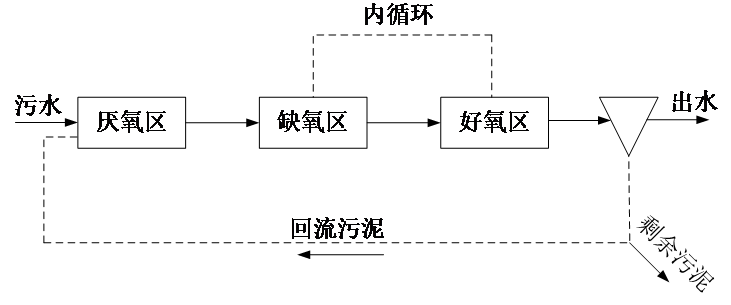
图1.1 A2/O生物脱氮除磷工艺流程
目前在城市生活污水的处理,传统生物脱氮是一种常见的工艺,其在低浓度氨氮废水的处理方面有较好的应用,氨氮去除率可达 70%以上[10],但由于传统生物脱氮技术中硝化-反硝化工艺不仅运行操作复杂,周期长,、有毒有害物质等影响,还存在需要外加碳源、耗氧量高、污泥产率高等缺点,而且其与除磷工艺在停留时间和碳源的需求上难以调和的矛盾导致了该工艺的脱氮效率难以进一步提高。一些新型生物脱氮技术成为目前脱氮研究的热点。
新型生物脱氮技术
(1)短程硝化反硝化
在传统生物脱氮工艺中,(,全程硝化),再进一步被还原成氮气(,全程反硝化)。Voets等人[11]研究发现硝化过程中会出现大量积累的现象,并且在反硝化细菌的代谢过程中,和 均可以作为其最终受氢体,因此他们提出了短程硝化-反硝化生物脱氮理论(Partial nitrification and denitrication),利用AOB和NOB生理特性的差异,通过改变环境条件如pH、温度、溶解氧[12]浓度等抑制NOB的活性,将-N氧化至 -N,然后直接进行反硝化作用。根据(公式1.1、1.2、1.4、1.5)可以看出,该工艺与传统生物脱氮工艺相比降低25%的耗氧量以及40%的有机碳需求量。同时 还能缩短反应时间、减少投碱量、削减底泥产量、进而减少反硝化池容积[13]。因此该工艺的经济性能甚好,是各类脱氮工艺中的热点研究。
还能缩短反应时间、减少投碱量、削减底泥产量、进而减少反硝化池容积[13]。因此该工艺的经济性能甚好,是各类脱氮工艺中的热点研究。
(2)厌氧氨氧化
以上是毕业论文大纲或资料介绍,该课题完整毕业论文、开题报告、任务书、程序设计、图纸设计等资料请添加微信获取,微信号:bysjorg。
相关图片展示:
